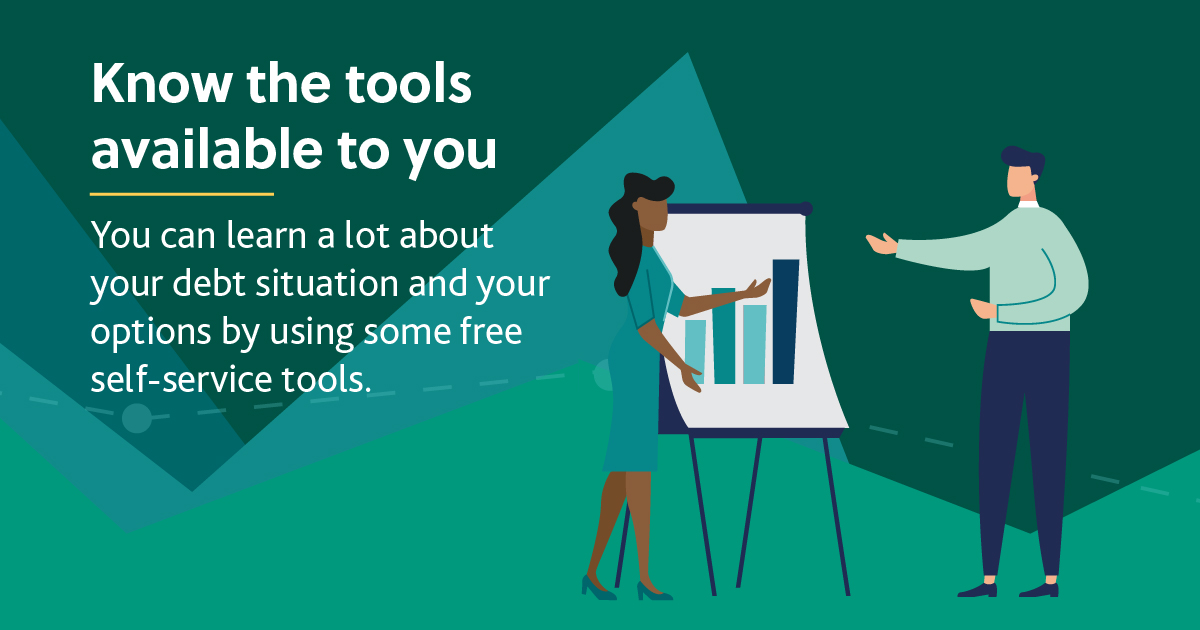Debt tools and how to use them
Financial Literacy Month: Part 2 of a 10-part blog series on your financial well-being?
Throughout November, consult this series of blog posts to learn more about your current finances — and how to set yourself on a path to financial freedom.

Congratulations, you’ve decided to take a closer look at your financial health! This is going to be an extremely rewarding journey. Finding a strategy that works best for you will also require a lot of research and experimentation.
The good news is that you’ve come to the right place. We have all the tools and tips you’ll need to paint a clear picture of your financial situation.
Do-it-yourself tools like the MNP Debt Calculator and the MNP Debt Scale are a great place to start and will help determine your next steps. If your situation is serious, you can also schedule a Free Confidential Consultation with an MNP Licensed Insolvency Trustee to discuss your options and to learn if Bankruptcy or a Consumer Proposal might be right for you.
Here is a list of MNP’s most helpful online tools and how to use them.
MNP Debt Calculator
Before you can develop a plan for overcoming your debt, you’ll need to come face to face with your situation and the available options. That’s where the MNP Debt Calculator can help.
This tool considers all the assets you own, how much you earn, and how much you owe, along with your interest rates and repayment schedules. We use this information to determine the estimated total cost and monthly payments associated with four common methods:
- Bankruptcy
- Consumer Proposal
- Orderly payment of debts (if available in your province), and
- Debt management program
To use the debt calculator, you’ll need a full list of all your assets and debts.
Assets include your income, the incomes of other individuals in your household, the value of your home and other real property you own, vehicles, and investments (but not RRSPs). Debts include any outstanding personal loans, credit cards, car loans, and lines of credit (but not your mortgage). The tool assumes an average interest rate of 12 percent across all debts.
Once you provide all the relevant details, the debt calculator will create a graph that directly compares your options so you can decide which one best fits your budget.
MNP Debt Scale
You know that you’re struggling with your debt. But do you understand the severity of your situation? The MNP Debt Scale can help you gauge your financial risk level and how urgently you need to address it.
This short survey asks a series of yes or no questions about your bill payments, budget, debt, and credit use. You won’t need to provide specific numbers, but you should be familiar with your current debt and some of your financial patterns.
Be ready to answer questions like:
- Are you making payments on time?
- Do you pay the minimum, or do you carry debt month-to-month?
- Are you falling behind on taxes or child support payments?
- Are you receiving calls from creditors?
The assessment only takes about five minutes. We will rate your situation from low to severe and provide suggestions for your next steps — including whether you should speak with a Licensed Insolvency Trustee.
MNP Budget Tracker
A monthly budget is your best tool to eliminate debt and build lasting wealth. Unlike the previous two tools, the MNP Budget Tracker is ideally something you will keep using month after month. Start using it now to see the complete picture of your monthly earnings, costs, and the steps required to pay down your debt.
A good budget is essentially a plan for how you will spend your hard-earned income. It may be helpful to print off your bank statements for the last three months to find out:
- How much did you make?
- Where did your money go?
- What costs were one-time payments (e.g., theatre tickets)
- Which ones recur every month (e.g., rent, insurance, utilities)?
You should have a zero balance after subtracting your income, expenses, debt payments, and savings from your income. If you’re spending more than you earn, that’s likely one of the most significant contributors to your current debt situation. That means you either need to spend less or earn more. Look for costs you can eliminate, such as meal delivery, unused subscriptions, and shopping.
Enter all your information into our pre-formatted spreadsheet. All the formulas and calculations are already set for you. We recommend keeping all your receipts and updating the Budget Tracker monthly, at a minimum, and ideally weekly or daily. For automatic withdrawals, you can either set up notifications through your online banking or set a reminder to check your accounts to ensure you capture everything.
This budget will be essential for determining your current financial well-being and what steps to take moving forward. Once you take those steps, continue to use the budget tracker as a tool for your ongoing financial management.
Taking the next step
Each of these tools can help to put you on the path to debt freedom. Visit our Do-It-Yourself Debt Solutions page for more information on each tool and to try them for yourself.
Remember, even though we’ve made it easy to take charge of your debt-free journey, you don’t have to do it alone. You can always contact a Licensed Insolvency Trustee for a Free Confidential Consultation to assess your debt situation and learn more about your options.
Now it’s time to decide if Bankruptcy or a Consumer Proposal is the right path for you — or whether another alternative may be more appropriate for your situation and goals. The next blog in the 10-part Financial Literacy Month series will review each of these solutions to help you decide your next steps.
Next Blog: Part 3: Review your options: Bankruptcy, insolvency, or other alternatives

